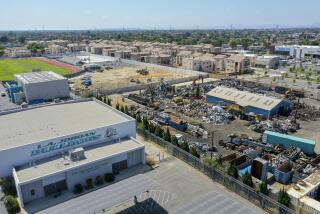In Rocketdyne Blast, Answers Are Due : Was the company illegally burning hazardous wastes when two physicists were killed?
- Share via
What was really happening on July 26, 1994, when two physicists from Rockwell International’s Rocketdyne division west of Chatsworth were killed in a blast? It’s time that we had an answer.
The blast that morning at a rocket engine test site on a rugged plateau in the Simi Hills was so powerful that nearby residents mistook it for an earthquake. Physicists Otto K. Heiney and Larry A. Pugh were killed.
Almost immediately, a Rockwell spokesman explained that the two victims were preparing for a controlled burn of a catalyst used in solid fuel rocket motors. “It wasn’t supposed to explode,” the spokesman said. He added that the material involved in the blast was to be burned to determine its characteristics so it could be properly packaged, labeled and transported. Later, the term “overpressure test” was employed.
By January, the California Division of Occupational Safety and Health had cited Rockwell for four “willful-serious” workplace-safety violations involving $200,000 in penalties. Rockwell’s appeal of these is still pending. The cause of the blast remained a mystery, and there was no publicly disclosed reason to suspect that the incident was the result of anything other than a test or experiment gone awry.
But that was before July 13, when 40 agents from the FBI, the Environmental Protection Agency, NASA, and the U.S. Departments of Defense, Energy, Air Force and Navy conducted a highly unusual raid of Rocketdyne’s Santa Susana lab and Canoga Park headquarters. Files related to the blast were seized.
Within days, it was disclosed that federal agents were investigating whether the scientists were really blowing up toxic waste instead of conducting valid rocket fuel tests. The burning off of unneeded rocket fuel chemicals is a violation of federal environmental laws and a breach of cleanup contracts that have paid Rockwell more than $1 million.
Now we’re told that blowing up explosive waste was routine at Rockwell and other defense and aerospace facilities in the ‘60s. It was all supposed to have stopped by 1992, when Rockwell and the state of California settled a broad hazardous-waste lawsuit. Rockwell says that the materials involved in the blast were not “wastes.”
Now, more than one year later, we are no closer to a definitive explanation and the implications continue to grow. The increasingly complicated investigation into this case needs to proceed to a conclusion as quickly and thoroughly as possible.
More to Read
Inside the business of entertainment
The Wide Shot brings you news, analysis and insights on everything from streaming wars to production — and what it all means for the future.
You may occasionally receive promotional content from the Los Angeles Times.










